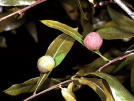San Antonio Express-News
GARDENING, ETC
Sunday, December 5, 2004
 Many of us are now seeing the annual display of thousands of white, tan, pink, red and brownish-grey “balls.” These timely “holiday ornaments” occur naturally this time of year and are caused by an insect so small and unobtrusive that it routinely goes unnoticed. Many of our callers inquire about these “weird balls” on the oak leaves; most people want to know how to get rid of them.
Many of us are now seeing the annual display of thousands of white, tan, pink, red and brownish-grey “balls.” These timely “holiday ornaments” occur naturally this time of year and are caused by an insect so small and unobtrusive that it routinely goes unnoticed. Many of our callers inquire about these “weird balls” on the oak leaves; most people want to know how to get rid of them.
The “balls,” in fact, are called galls. So, what is a gall, and how does it occur? Galls are abnormal swellings of plant tissue induced by insects, bacteria,  fungi, mites and nematodes. Gall tissue is formed in response to a specific stimulus received from an insect. It is thought that the stimulus occurs either when insect eggs are deposited in the host plant tissue or when eggs hatch and larvae feed on the host plant. In either case, insect chemicals, possibly secreted from special internal glands, interact with certain plants chemicals to produce abnormal plant growth. After a brief period of cell growth, gall development stops completely. The insect lives within the protective gall and feeds on soft tissue during its development. Once formed, these gall growths no longer drain the host plant of its nutrients. Insect-induced galls are considered harmless to the growth and development of almost all ornamental plants. Insect-induced galls are the most common galls in urban areas. Among the insects causing galls are certain moth caterpillars, beetles, flies, aphids and small wasps.
fungi, mites and nematodes. Gall tissue is formed in response to a specific stimulus received from an insect. It is thought that the stimulus occurs either when insect eggs are deposited in the host plant tissue or when eggs hatch and larvae feed on the host plant. In either case, insect chemicals, possibly secreted from special internal glands, interact with certain plants chemicals to produce abnormal plant growth. After a brief period of cell growth, gall development stops completely. The insect lives within the protective gall and feeds on soft tissue during its development. Once formed, these gall growths no longer drain the host plant of its nutrients. Insect-induced galls are considered harmless to the growth and development of almost all ornamental plants. Insect-induced galls are the most common galls in urban areas. Among the insects causing galls are certain moth caterpillars, beetles, flies, aphids and small wasps.
Gall wasps belong to the family of wasps called Cynipids. These wasps rarely grow larger than one-fourth inch in length and cause no harm to humans or animals. Gall wasps lay their eggs on the new green oak leaves as they bud on the tree. These eggs secrete chemicals that stimulate the leaf to surround the egg with protective leaf tissues, forming a gall. The gall becomes a nursery for the developing wasp, providing nutrients via the sap of the tree. The wasp larva develops through the year and emerges in late winter or early spring to continue the life cycle.
The mealy-oak gall is one of the most common galls found on live oak. The gall is induced by a small wasp, Disholcaspis cinerosa. It grows on its own stem and can be nearly one inch in diameter. Again, this gall does not harm the tree, and develops in harmony with the natural growth of the tree. The second most common gall is the wooly oak gall. Wooly oak galls are one-fourth to three-eighth inch in diameter and covered with a dense growth of white, tan or brown hairs. Probably the largest of the oak galls is the oak apple gall. It occurs on red oaks and can grow to two inches in diameter. This gall produces one wasp per year during the normal growth pattern.
And what about the coloration? If the galls are pale to medium pink and red, the infestation cycle is in the beginning to mid life stage. If the galls are grey, the tree is in a declining period of gall production. If there are equal numbers of colorful and grey galls, the infestation is either just beginning to increase or is in the early phases of decline.
Long-term studies have suggested that a tree is infested with galls for a two to three year period, and then gall numbers begin to decline on that particular tree. As mentioned before, galls do not cause any sort of harm to the host plant. Because the galls grow on the underside of the leaves, the photo-synthetic cells on the upper leaf surfaces are not disrupted. This allows the tree to produce food for itself in a normal fashion. Granted, the galls are not always pleasing to the eye, but they are not nearly as detrimental as oak wilt disease or a wood boring beetle infestation.
In controlling galls, there is no effective chemical solution, as the resident insect is completely protected inside of the tough woody gall. Galls can be attacked by parasitic wasps which provide a natural control. Parasitized spherical galls can be recognized easily by their smaller size. Parasitized galls generally measure one-eighth to one-half inch in diameter, while un-parasitized galls are one-half to one inch in diameter.
If you would like more detailed information, there is an excellent, 13 page Extension publication online, “The Mealy Oak Gall on Ornamental Live Oak in Texas,” #MP-1315. This publication includes color photos and a question and answer page. Access this web page at: http://insects.tamu.edu/extension/bulletins/mp-1315.html.
This article was submitted by Lynn Rawe, County Horticulture Agent with Texas Cooperative Extension in Bexar County, and edited by Extension staff.
